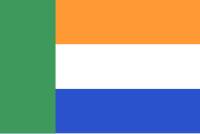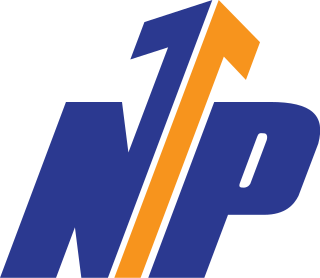
The National Party, also known as the Nationalist Party, was a political party in South Africa founded in 1914 and disbanded in 1997. The party was an Afrikaner ethnic nationalist party that promoted Afrikaner interests in South Africa. However, in 1990 it became a South African civic nationalist party seeking to represent all South Africans. It first became the governing party of the country in 1924. It merged with its rival, the SAP, during the Great Depression, and a splinter faction became the official opposition during World War II and returned to power and governed South Africa from 4 June 1948 until 9 May 1994.

The Freedom Front Plus is a right-wing political party in South Africa that was formed in 1994. It is led by Pieter Groenewald. Its current stated policy positions include abolishing affirmative action, replacing it with merit based appointments, and being firmly against the proposed expropriation without compensation land reform movement to protect the rights and interests of minorities, especially Afrikaners and Afrikaans speaking Coloureds. The party also supports greater self-determination for minorities throughout South Africa, and expressly has adopted Cape Independence as an official party position.
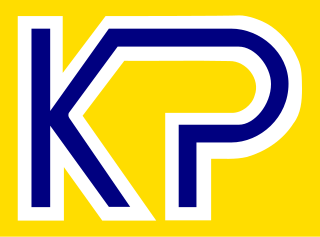
The Conservative Party of South Africa was a far-right South African political party that sought to preserve many aspects of apartheid in the system's final decade, and formed the official opposition in the white-only House of Assembly in the last seven years of minority rule. It declined quickly after apartheid ended, before being merged with the Freedom Front in 2004.

The Afrikaner Weerstandsbeweging, meaning "Afrikaner Resistance Movement", commonly known by its abbreviation AWB, is an Afrikaner nationalist, neo-Nazi, and white supremacist paramilitary organisation in South Africa. Since its founding in 1973 by Eugène Terre'Blanche and six other far-right Afrikaners, it has been dedicated to secessionist Afrikaner nationalism and the creation of an independent Boer-Afrikaner republic or "Volkstaat/Boerestaat" in part of South Africa. During bilateral negotiations to end apartheid in the early 1990s, the organisation terrorised and killed black South Africans.
The following lists events that happened during 1933 in South Africa.

The Herstigte Nasionale Party is a South African political party which was formed as a far-right splinter group of the now defunct National Party in 1969. The party name was commonly abbreviated as HNP, evoking the Herenigde Nasionale Party, although colloquially they were also known as the Herstigtes. The party is, unlike other splinter factions from the National Party, still active but politically irrelevant.

General Constand Laubscher Viljoen, was a South African military commander and politician. He co-founded the Afrikaner Volksfront and later founded the Freedom Front. He is partly credited with having prevented the outbreak of armed violence by disaffected white South Africans prior to post-apartheid general elections.
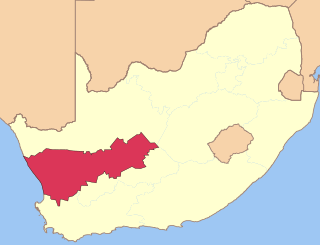
The concept of a Volkstaat, also called a Boerestaat, is a proposed view to establish a White ethnostate Afrikaner homeland within the borders of South Africa, most commonly proposed as a fully independent Boer/Afrikaner nation. The concept excludes Afrikaans-speaking coloureds but accepts South Africans of English ancestry and other White South Africans, if they accept Afrikaner culture and customs.
Ferdinand Hartzenberg was a South African politician and the second and last leader of the Conservative Party in South Africa between 1993 and its merger with the Freedom Front in 2004. He obtained a DSc (Agriculture) from the University of Pretoria.

The apartheid system in South Africa was ended through a series of bilateral and multi-party negotiations between 1990 and 1993. The negotiations culminated in the passage of a new interim Constitution in 1993, a precursor to the Constitution of 1996; and in South Africa's first non-racial elections in 1994, won by the African National Congress (ANC) liberation movement.

Afrikaner nationalism is a nationalistic political ideology created by Afrikaners residing in Southern Africa during the Victorian era. The ideology was developed in response to the significant events in Afrikaner history such as the Great Trek, the First and Second Boer Wars and opposition to South Africa's entry into World War I.

The Boerstaat Party is a Boer nationalist South African political party founded on 30 September 1986 by Robert van Tonder. It was never officially registered as a political party because it was unable to rally 500 persons under one roof, a requirement under South African electoral law for official political party status. It was never represented in the South African Parliament, neither in the apartheid era nor after democratisation. In 1989, it joined the Afrikaner Weerstandsbeweging (AWB) in declaring support for Jaap Marais, the leader of the Herstigte Nasionale Party and has worked with the HNP on occasion since. The party was a charter member of the Afrikaner Volksfront coalition group. It has also operated with the paramilitary group, the Boere Weerstandsbeweging led by Andrew Ford.
The storming of the Kempton Park World Trade Centre took place in South Africa on 25 June 1993 when approximately three thousand members of the Afrikaner Volksfront (AVF), Afrikaner Weerstandsbeweging (AWB) and other right-wing Afrikaner paramilitary groups stormed the World Trade Centre in Kempton Park, near Johannesburg. At the time of the attack the World Trade Centre was the venue for multi-party negotiations to end the apartheid system through the country's first multi-racial elections. These negotiations were strongly opposed by right-wing white groups in South Africa. The invasion came after other clashes between police and right-wingers, such as the Battle of Ventersdorp, and much belligerent rhetoric from right-wing leaders such as Eugène Terre'Blanche of the AWB.
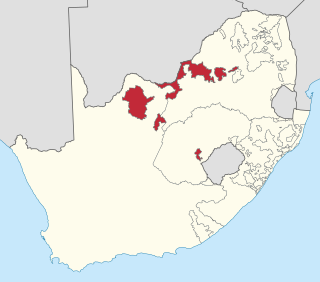
The 1994 Bophuthatswana crisis was a major political crisis which began after Lucas Mangope, the president of Bophuthatswana, a South African bantustan created under apartheid, attempted to crush widespread labour unrest and popular demonstrations demanding the incorporation of the territory into South Africa pending non-racial elections later that year. Violent protests immediately broke out following President Mangope's announcement on 7 March that Bophuthatswana would boycott the South African general elections. These escalated into a civil service strike and a mutiny in the local armed forces, which was complicated by the arrival of right-wing Afrikaner extremists ostensibly seeking to preserve the Mangope government. The chaos lasted about four days before the president bowed to pressure and agreed to allow participation in the upcoming elections. However, Mangope once again reversed his decision. The South African Defence Force (SADF) responded by deposing him and restoring order on 12 March.

Many people of European heritage in South Africa are descended from Huguenots. Most of these originally settled in the Cape Colony, but were absorbed into the Afrikaner and Afrikaans-speaking population, because they had religious similarities to the Dutch colonists.

Jacob Albertus Marais was an Afrikaner nationalist thinker, author, politician, Member of Parliament, and leader of the Herstigte Nasionale Party (HNP) from 1977 to his death in 2000. Marais is the longest serving head of any political party in Afrikaner history, with a term of 23 years.

The White Liberation Movement was a small but notorious South African neo-Nazi organisation which became infamous after being banned under the Apartheid regime, the first right-wing organisation to be so banned. It regarded itself as the most far-right organisation in South Africa.
The Institute for Democratic Alternatives in South Africa (IDASA) later known as the Institute for Democracy in South Africa was a South African-based think-tank organisation that was formed in 1986 by Frederik van Zyl Slabbert and Alex Boraine. Its initial focus from 1987 was creating an environment for white South Africans to talk to the banned liberation movement in-exile, the African National Congress (ANC) prior to its unbanning in 1990 by the President F. W. de Klerk. After the South African election in 1994, its focus was on ensuing the establishment of democratic institutions in the country, political transparency and good governance. Caught up in a funding crisis after the 2008 global financial crisis, closed in 2013.

The Bophuthatswana Defence Force was established on 6 December 1977 from trainees of the South African Defence Force. It was the defence force of the Republic of Bophuthatswana, a nominally independent bantustan during the Apartheid era of South Africa.
The Accord on Afrikaner self-determination is a South African political accord that recognises the right of the Afrikaner people on self-determination. The accord was signed by the Freedom Front, the African National Congress and the National Party-led South African government on 23 April 1994.
